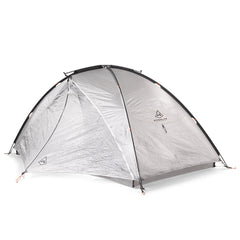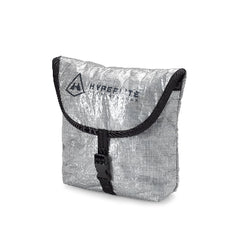It wasn’t predicted to rain, so we didn’t plan for rain. But let’s not jump ahead.

On Thursday after work, Bobby, Emery, Danica, Mark, and I made the four-hour drive from Phoenix to Grand Canyon, stopping in Flagstaff along the way. After burritos for dinner, Mark realized he had forgotten his hiking shoes, but he also did some Googling, and we were optimistic that he could buy replacements at the South Rim general store on Friday morning. At Mather Campground, the 7,000 ft of elevation made for a chilly evening, but it was a welcome respite from the Valley of the Sun and the coolest we would be for the next few days, so we took advantage of the nice sleeping temperatures and got to bed without much ado.
On Friday morning, we woke up around six, took care of morning tasks, and did a final gear check before researching footwear options for Mark. Luckily, shoes were available, and we were able to start heading down the Bright Angel trail by eight. It’s about 4.5 miles and 3,000’ of elevation loss to Havasupai Gardens, and we had all hiked this section of trail before. When most of us did it on a Friday evening in May, we were a little disappointed that the canyon rim blocked out the full moon, making it darker than we had hoped. This time around, the same geometry provided almost complete shade and kept us cool for an additional two hours. The highlight of the descent was seeing a pair of bighorn sheep that we carefully circumvented while dayhikers took photos.

After filling up on water and snacks and wetting our clothes to help with evaporative cooling, we took a left on the Tonto Trail and began about three miles of quiet, rolling, sunny singletrack. The distant peaks and glimpses of the river beckoned us along, and we made it to Horn Creek in a single push, where we left the trail and began the next leg of our adventure. Our plan was to follow the Horn Creek drainage down to the Colorado, rockhopping, downclimbing, and rappelling along the way. While we’ve done several other technical canyons in the immediate vicinity, this was new territory for all of us.

Through a combination of the Grand Canyoneering guidebook and the ropewiki website, we had the beta we needed to safely descend the canyon. There were only two rappels in the description, but we encountered anchors for three and used them all. Water was trickling but not flowing, and there were no pools or other obstacles to complicate the rope work. It never became a true slot canyon, but the polished flutes were pretty, and the towering walls surrounding us provided welcome shade after the Tonto platform. After three rappels, 1.75 miles, and another 1,100 feet in elevation loss, we made it to the Colorado River around 3:15, where we were excited to dip our toes in the water and rehydrate.

Some people do Horn Creek as an out-and-back journey, fixing ropes in place and climbing back up. Instead, we chose to bring packrafts and float about a mile downriver to Ninetyone Mile Canyon. Bobby, Emery, and I have done multiple Grand Canyon packrafting trips together, and we had done a practice jaunt with Mark & Danica a few weeks earlier on the much tamer Salt River in Phoenix. The put-in at Horn Creek rapid was rumored to be rather tricky, but the continuing drought in The West meant water levels were 4-5 feet below usual, allowing us to bypass most of the turbulence by walking farther down the South Bank. Altogether, it took us about an hour to get the boats out of our packs, inflate them, situate gear, and get on the water. A more experienced group could probably cut that time down to 30 minutes or less, but taking our time allowed us to help each other and ensure the transition went as smoothly as possible.

The last mile of our day’s journey was a glorious float down mostly calm water to our campsite. After the full day, it was refreshing to let the current push us along, only paddling for orientation or to more closely examine things along the banks. We made it to our campsite around five, and spent the next three hours swimming in the river, drying out gear, almost noodling a fish, taking care of dinner chores, and enjoying a glorious sunset, all while feeling like we had the entire river to ourselves.

But there’s always a catch. In addition to our regular backpacking gear, we were carrying:
● 300’ rope - 8 lbs
● Five packrafts - 1.75-6 lbs each
● Five paddles - 1-2 lbs each
● PFDs, harnesses, helmets, carabiners, descenders, ascenders, webbing, and additional rappelling gear
Our packs started at 28-35 lbs, and after looking at the weather report, we elected to cut weight by not bringing tents, tarps, or really any significant form of shelter. So, when I was woken up a little after midnight by a raindrop ker-plunking into my ear, I didn’t think there was much I could do about it. I wasn’t cold, and it wasn’t raining very hard, but my lizard brain kept yelling, “DANGER, DANGER. DO NOT SLEEP. YOU NEED TO FIX THIS,” so I tossed and turned and fretted for the rest of the night. Maybe Kat Englishman would have had some on-trail meditation tips to relax the brain, but I was out of ideas. Luckily, my group mates were wiser than I was.
● Emery slept under her deflated boat.
● Bobby opted to shelter beneath an inflated boat.
● Mark & Danica pulled their Tyvek ground sheet over their heads.
While I was wandering around in the middle of the night, I saw all of these options and just elected not to employ them. I was a little concerned about a boat or a piece of plastic blowing away in the (very slight) breeze, but I also think I got wrapped up judging myself for not planning better. Instead of addressing the situation that existed, I spent a lot of energy regretting my choices, thinking, “If only.” Finally, close to dawn, I was able to get another hour of sleep under the groundsheet I had had available all night. The Tyvek didn’t provide loads of protection, but something about keeping the rain off my face allowed my body to relax, and the additional rest was a significant improvement.

Our plan for Saturday had been to do a second canyon on the north side of the river that would have added about five miles, 1,600’ of elevation gain, and a few rappels. But the restless night before, the continuing gray and wet weather, and the possibility of slick rock on both our ascent and descent pushed us to reconsider. After a discussion, we unanimously decided to skip the canyon and head straight downriver two miles to Granite Beach. Despite the precipitation and my sour mood, it was a magnificent float. I took a heron sighting during our departure as a good omen, and then an osprey that guided us through a few riffles continued the buena fortuna. The trip beta advised takeouts at two rapids, but the lower water levels made both of them paddleable. So, despite a late start, we made it to our takeout by 11. Our campsite was about an hour away, and we were in no hurry to get there, so we ate, swam, napped, cliff-jumped, and had a very enjoyable lazy afternoon during a welcome break in the rain.

Around 2:30, we started heading uphill to our campsite just as the rain/drizzle returned. People in Patagonia, the Pacific NW, or other rainier places would probably laugh at how much the precipitation affected us, but they would also consider 90º hot, and for Phoenicians, it’s pretty comfortable. It’s amazing what you can get accustomed to. After a five-minute wrong-turn detour, we made it to our campsite just as the heavens erupted. Luckily, a spacious overhang provided shelter for us to wait out the downpour and share our incredulity with another group who had read the same weather report as us. Mercifully, the four p.m. deluge was the storm’s swansong, and the ensuing sunbeams perforating the clouds evoked Hallmark Easter cards. As we made dinner, purified water, and tended to our bodies and gear, the moon rose, and we enjoyed watching the clouds roll in and out of the side canyons before mental and physical exhaustion tucked us into bed around eight p.m.

Saturday night was much less eventful but included post-rain humidity condensing onto our sleeping bags–a rarity in the desert. We tried our best to air everything out before we got moving on Sunday morning, but we wanted to get an early start and gain elevation before the sun warmed things up along the 8.5 miles and 4,000’ of climbing that lay in front of (and above) us. The Hermit Trail is not as steep as some other canyon exits, but as a friend recently shared, “It feels like it takes as long to make it through the last layer of Kaibab Limestone as it did for it to form.” The last 1.5 miles did feel like a bit of a slog, but the changing views and promise of a post-adventure burger beckoned us back to the car. At the time, it was pretty exhausting, but less than a week later, we all agreed we were ready to return.

NOTES ON GEAR
We used a variety of packrafts for our journey. We had three Matkat Flatwater Boats from Supai Adventure gear (1.75 lbs each), an Alpacka Ghost (2.25 lbs), and an Alpacka Refuge (5.75 lbs). I’ve used the Matkats on about 18 miles of the Colorado River on past trips. They are perfect for river crossings and provide a lot of flotation for weight penalty. The downside is that they don’t track very well, and any significant downriver travel becomes spicy pretty quickly. For “just” a half pound more, the Alpacka Ghost would be my first choice for an adventure of this sort - it has a significantly larger cockpit and markedly improved tracking. For another 3.5 lbs, the refuge provides a spray skirt and cargo fly, which allows you to store gear inside the tubes while you’re paddling. This frees up space in the cockpit and creates a lower, wider center of gravity, noticeably increasing stabilization and drastically reducing the likelihood of getting your gear wet. But for three miles of relatively easy paddling, it’s probably overkill. Much like backpacks, shoes, cars, and most other consumer goods, there’s no one perfect do-it-all boat, so I hope this breakdown is useful for people considering getting into this outdoor option.
Finally, the packrafting and canyoneering gear added to the overall weight of our packs, but we absolutely could have brought some sort of shelter. The Ultamid 4 and stakes weigh less than two pounds, and without the insert, we probably could have squeezed five people into its shelter. In addition to the protection from the elements, some sort of rain fly would have provided a lot of peace of mind while they weren’t in use. Knowing that we had somewhere to shelter would have made hiking through the rain much less daunting. The moral of the story: even if you have an experienced crew that can stay positive in adverse situations, it doesn’t hurt to have a backup plan.
























